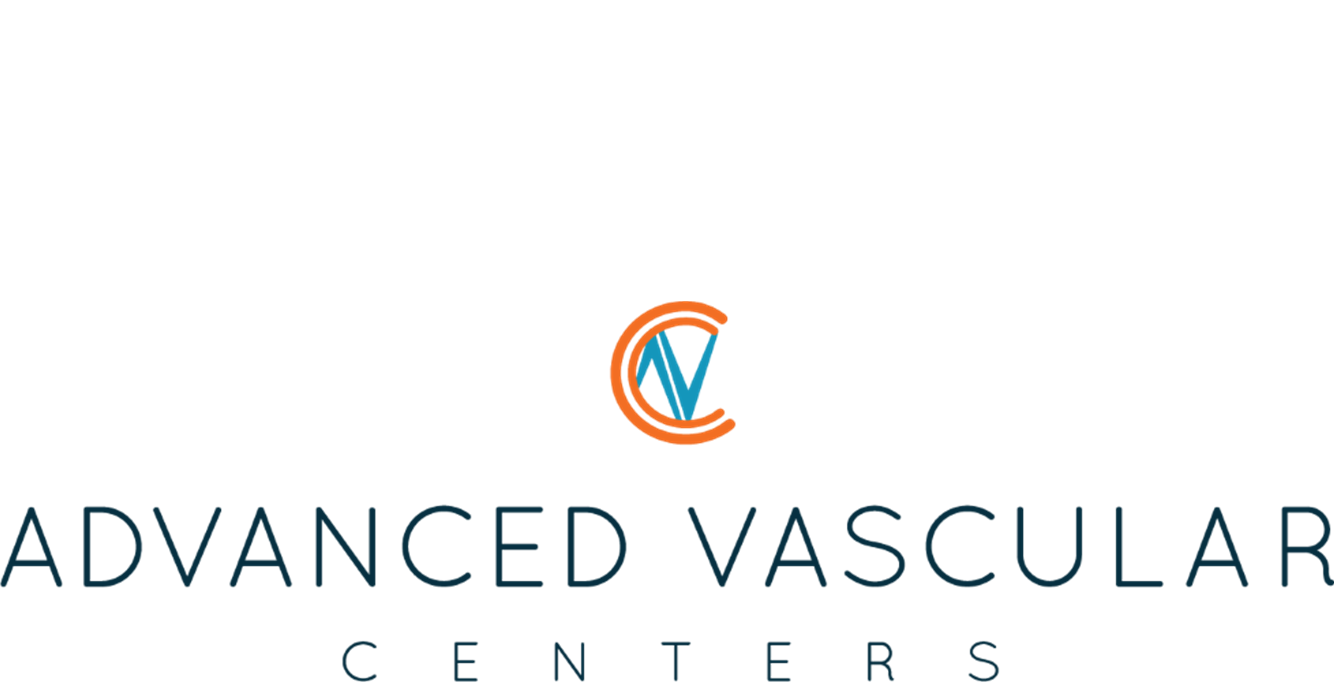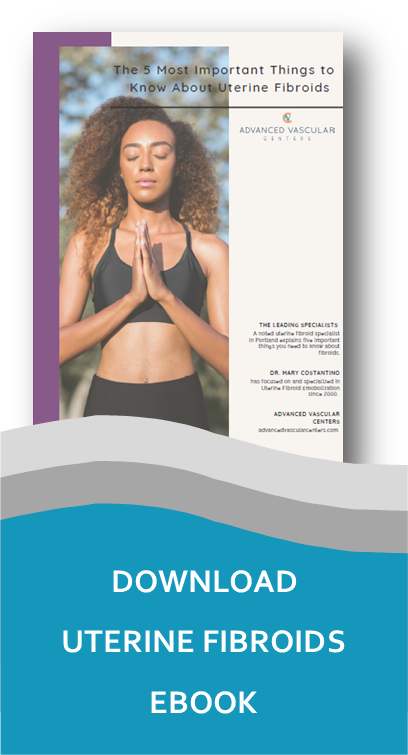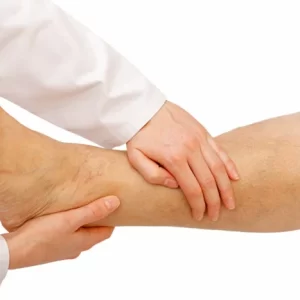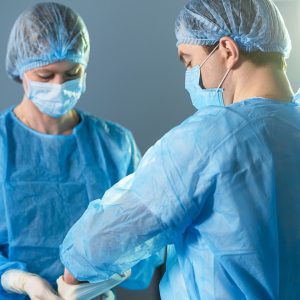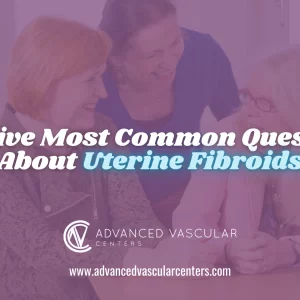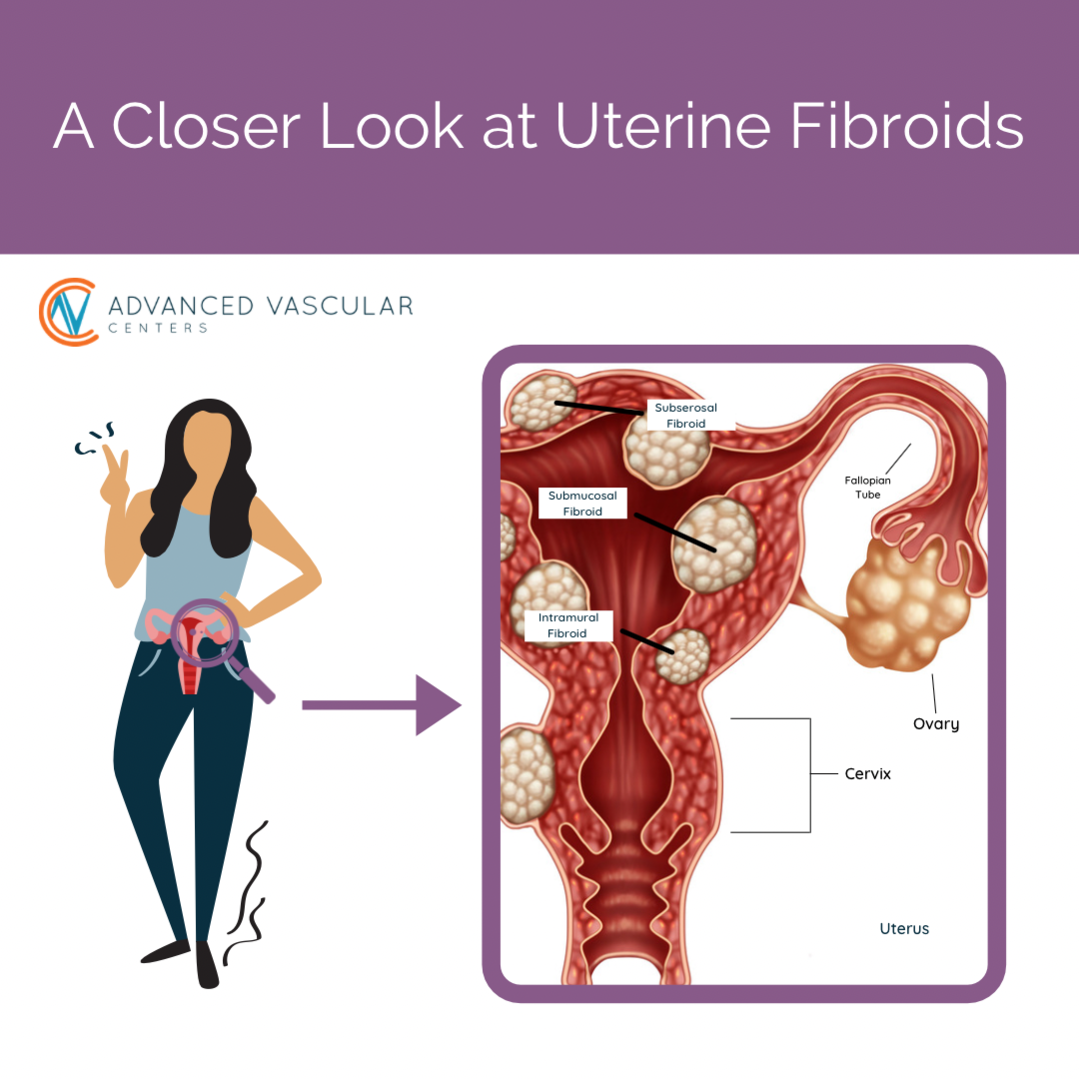FIBROIDS – WHAT THEY ARE, WHAT THEY AREN’T, AND WHO GETS THEM
70% of women will have uterine fibroids in their life.
Uterine Fibroids are the most common benign tumor of the uterus and can cause symptoms such as heavy bleeding, pelvic pain or pressure, painful sex, constipation, and urinary frequency.
At AVC, our award-winning physicians are expertly trained to use non-surgical minimally invasive procedures, using advanced imaging and device technology, to achieve effective results. During the same-day outpatient procedure, the uterus is not removed and unlike traditional surgeries, you won’t have a large incision or stitches.
DOWNLOAD UTERINE FIBROID E-BOOK (FREE)
Written by AVC – Portland’s Medical Director Dr. Mary Costantino, this e-book outlines the five most important things to know about fibroids.
Contact AVC to see if a non-surgical procedure may be right to treat your fibroids.
Uterine Fibroid Overview
Uterine fibroids are considered “benign” because they are not as-sociated with any increased risk of uterine cancer. But that does not mean that fibroids do not cause moderate to severe symptoms.
Fibroids are muscular tumors that grow in the wall of the uterus during a woman’s childbearing years. Also called leiomyomas or just myomas, fibroids can grow as single tumors, or in groups of them. They range in size from the size of a pencil eraser to bulky masses that can distort and enlarge the uterus. In unusual cases they can become very large, the size of a grapefruit, or even a small watermelon. Fibroid tumors are NOT cancerous. Uterine fibroids are not associated with an increased risk of uterine cancer and do not turn into cancer. There is a malignant form of a fibroid, called a leiomyosarcoma, which is fortunately rare. Leiomyosarcomas are fast growing and have MRI characteristics that are different from benign fibroids.
In terms of “who gets fibroids,” the answer is “most women. ”It has been estimated that as many as 50–70% of Caucasian women and 80% of African-American women develop fibroids by the age of 50. That said, there are factors that can increase your risk of developing fibroids:
- Age. Fibroids become more common as you age, especially during your 30s and 40s. After menopause, fibroids can slowly shrink.
- Family history. If you have a family member who has fibroids, your risk is higher. For example, if your mother had fibroids, your risk of developing them yourself is about three times higher than average.
Ethnicity. African-American women are more likely to develop fibroids than Caucasian women, and are more likely to develop fibroids at younger ages. - Identical twins are more likely to develop fibroids than non- identical twins.
- Obesity. If you are overweight, you have a higher fibroid risk. For obese or very heavy women, the risk is two to three times greater than average.
- Environmental factors. Onset of menstruation at an early age, use of birth control, having a vitamin D deficiency, having a diet high in red meat and low in vegetables, and drinking alcohol all appear to increase your risk of developing fibroids.
Uterine Fibroid Symptoms
Symptoms fall into two categories: those related to bleeding, and those related to bulk. The symptoms of uterine fibroids usually start with mild increased cramping with menses and/or a slight increase in bleeding during periods. As the fibroids grow, the symptoms will progress and can be severe enough to land the patient in the hospital.
The most debilitating symptom is heavy periods. A patient with moderate symptoms may change a pad or tampon once every 3–4 hours, a patient with heavy symptoms will change a pad or tampon every 1–2hours. Often there are clots, and flooding (a gush of blood). Anytime a woman bleeds through clothes, gets up at night to change her pad/tampon, alters her schedule to be near a bathroom or avoid activities such as plane flights, drives or vacations because of her menses, the fibroids should be treated. Fibroids should NOT cause bleeding in between cycles.
Cycles become gradually heavier, which results in slowly progressing symptoms. Often a woman is not aware of how bad her situation is until she sits in front of a fibroid specialist and starts to talk about her cycle. Women are used to pushing through and putting up with symptoms, even when they are quite severe.
If you experience any of the following, a consultation for fibroid treatment is recommended:
- Prolonged menstrual periods that can last 7 or more days
- Bleeding through clothes
- Needing to wear tampons and super pads
- Wearing multiple layers of protection at night
- Knowing where all of the bathrooms are during your usual daily activities
- Changing plans or scheduling vacations around your cycle
- Symptoms of anemia – increased fatigue, dizziness
- Anemia – low ferritin, iron or Hemoglobin on a blood draw
- Need for iron or blood replacement
- Cycles becoming heavier and heavier over 6 months to a year
- Frequent urination
- Difficulty emptying the bladder
- Feeling of fullness in the lower stomach area
- Enlargement of the lower abdomen
- Pain during sex
- Pelvic pressure and lower backpain, leg pains
- Large or numerous fibroids with infertility
- Constipation
‘Bulk symptoms’ relate to the actual mass of the fibroid pushing on surrounding pelvic structures. The particular size and location of the fibroid will determine which bulk symptoms each woman experiences. The most common is a general heaviness in the pelvis, which can be positional. A woman may change the side that she sleeps on, be unable to sleep on her back or stomach, or maybe unable to do activities such as yoga or cycling.
The need to urinate frequently is another common bulk related symptom. This is because the uterus sits right on top of the bladder, and the fibroids push the uterus forward, which traps the bladder between the fibroid and the pubic bone. The bladder is a stretchy organ, but it can’t compete against the solid heavy fibroids. As the fibroids grow the bladder is pushed against the pubic bone, and cannot expand. Hence, theurge to urinate frequently, despite small volumes.
continue reading...
If your fibroids produce symptoms, they can affect your everyday activities and greatly reduce your overall quality of life. Many women say that their fibroids are so painful that it “puts them out of action” for several days a month, and they actually miss work because of them. Others fear that the fibroids will interfere with their desire to have children. And most women with symptomatic fibroids have to deal with heavy periods, cramps, and constant feelings of exhaustion.
Over time, these symptoms can make you feel irritable or even depressed. Symptomatic fibroids can even have a negative effect on your relationships. The emotional burden of heavy bleeding and pelvic symptoms can be disruptive to a relationship, and the frank amount of blood can be overwhelming. If I had a dime for every time I heard a husband who describes so much blood that it looks ‘like a murder scene’… Intercourse can be consistently painful, reducing the desire for intimacy. Constant and unrelenting fibroid symptoms can erode self- esteem and make a woman feel genuinely bad about herself.
As strange as it may sound, many women manage to ignore this longlist of disturbing symptoms. They tell themselves that the pain and discomfort are “just part of normal life for a woman.” Some women believe this so thoroughly that they don’t consult a doctor or uterine fibroid specialist, and try to “tough it out.”
Women are also very busy taking care of other people, between work, kids, managing households, we often put ourselves last. Because there is relief from the symptoms after each cycle, the severity can be forgotten. Women will think ‘it’s not that bad’ or
‘I’ll do something about this next month, but I’m fine for now.’ None of this is normal. There is no need to “tough it out” or pretend that such symptoms are “normal.” They aren’t normal, and there are effective treatments that can reduce or eliminate fibroid symptoms, and the fibroids themselves. In the next section we present information about some of these treatments.
None of this is normal. There is no need to “tough it out” or pretend that such symptoms are “normal.”
If you experience any of the following, contact us to discuss treatment options.
How Fibroids Are Treated & Options Available To You
When it comes to uterine fibroid treatment, you have options. When seeking treatment, the vast majority (I’d estimate >90%) of women throughout the country are told without discussion that they need a hysterectomy, and surgical scheduling for hysterectomy happens then and there. It can be extremely difficult for a woman to hear that she is about to have a hysterectomy.
Over the 15years that I have been treating fibroids, I have learned that this hesitation often has nothing to do with whether the woman wants to have more children. Women can be apologetic for wanting to keep their uterus, and I think we need to send a clear message that NO APOLOGY ISNECESSARY.
As doctors, we owe it to YOU, to give you two things:
- All of your treatment options, both surgical and non-surgical.
- Our professional opinion about each of these options for YOU.
FIBROID TREATMENT OPTIONS
When I consult with a woman, the consultation is rarely about ‘can I do an embolization’ as that is often a technically easy decision. The consultation is more about listening to the patient to decipher what she wants as her desired outcome. Women have incredibly strong instincts. Those instincts combined with my 10 years of training, with an additional >10years of experience, and my baseline knowledge of fibroids and treatment options will guide the two of us to the best treatment for each woman.
I believe 100% that educating a woman is empowering her to make the best decision for her.
For a woman who is still wanting to retain the option of child-bearing, hearing that she needs a hysterectomy instantly robs her of that desire. This is a very painful moment. Women with fibroids will have a decreased ability to conceive and carry a fetus to term, and realistic conversations about patient desires, realistic outcomes and options should be discussed. However, the answer is not that there are no options. The emotional distress that a woman who desires pregnancy feels when told that her only option is hysterectomy runs deep. Even if fertility is diminished, even if there is a lesser chance of carrying to term, acceptance and adjustment to this can be a journey. While we need to be realistic about the ability to carry a child, the long-term emotional consequence of a hysterectomy ‘against her will’ can be significant.
Social variables, such as amount of time a woman can afford to take off from a job, or care for loved ones, for recovery.
What constitutes the “best” or “most effective” treatment option for you depends on the severity of your symptoms, as well as your personal situation and goals, and your age. What works “best” to eliminate the symptoms of uterine fibroids or the fibroids themselves is very much an individual consideration.
At Advanced Vascular Centers – Portland, I am very dedicated to ensuring that every patient is fully informed. We are excellent at the technical aspect of the procedure, and believe we provide the best patient experience. Along with that, we want our patients to feel cared for and guided throughout the process. At each consultation we will present a comprehensive review of all ALL of the possible treatment options available to our patients.
Not all of these options are presented to women by their general practitioners or gynecologists. At AVC, we want to make sure that all fibroid patients are very clear about the different treatment options, so they can make the best decision about how to proceed. I work with the patients’ doctors – whether primary care physicians, gynecologist, or naturopaths, to ensure a very personal level of care.
We feel that the best care is provided by putting the patient first and working with the entire care team to achieve the best possible treatment outcome. Each fibroid patient is an individual, and thus deserves individual care to help guide them to the proper treatment choice.
If the fibroids are asymptomatic no treatment is necessary. In this case, watchful waiting is advised.
If the fibroids are causing symptoms –especially painful ones – there are treatments that can help. Which treatment is right for you depends on a number of factors, including:
- The severity of the symptoms
- The size and location of the fibroids
- Proximity to menopause
- Desire to become pregnant
- Medical risk factors
- Social variables, such as amount of time a woman can afford to take off from a job, or care for loved ones, for recovery.
FIBROID TREATMENT OPTIONS
Medication
If you have mild symptoms, your doctor may suggest taking medications. For cramping, this treatment might include over-the-counter drugs such as ibuprofen or acetaminophen. If you have mild to moderate bleeding during your period, low-dose birth control pills or a Merina IUD can help normalize this bleeding. Iron supplementation is also often recommended to prevent symptoms of anemia. In the case of very heavy periods, hormone control with an IUD or OCP’s may work, sometimes for up to several years. Other drugs, such as Lupron®, can shrink your fibroids, and is used to urgently stop a massive hemorrhage, but this is usually not a reasonable sustainable treatment.
Myomectomy
This is a surgical procedure to remove the fibroids without taking out the healthy tissue of the uterus. It is widely considered a good option for women who want to have children after treatment. Myomectomy is always an option that should be discussed. Certain situations such as multiple or numerous fibroids or large fibroids may pose a higher surgical risk. Myomectomy and UAE are the only uterine-sparing definitive treatment options for symptomatic fibroids.
Hysterectomy
Hysterectomy is the traditional surgical treatment for fibroids, with >500,000 hysterectomies performed each year. While hysterectomy is a desired treatment for some, many would opt for a less invasive treatment with as horter recovery time. Also, many women simply do not want to lose their uterus unless all other options have been excluded. One benefit of hysterectomy is that there will no longer be bleeding of any kind – whether due to the fibroids or hormones.
Endometrial Ablation
In this procedure, the lining of the uterus is destroyed to control very heavy bleeding. This can be done with a laser, wire loops, electrical current, microwaves, freezing, and other methods. Pregnancy after endometrial ablation must be avoided due to a high rate of ectopic pregnancy and miscarriage. After ablation there is no healthy lining of the uterus. Ablation is a good minimally invasive outpatient procedure, usually performed for heavy bleeding due to hormones or sometimes adenomyosis. It is less commonly offered for treatment of uterine fibroids, since it does not actually treat the fibroid.
Myolysis
In this procedure, a needle is inserted into the fibroids, usually guided by laparoscopy, and an electrical current or freezing is used to destroy the fibroids. Laparotomy involves an abdominal incision to remove the fibroids, no matter the size or location of the tumors.
Uterine Fibroid Embolization (UFE), or Uterine Artery Embolization (UAE)
With this procedure, a thin tube is inserted into the arteries that supply blood to the fibroid. Then, tiny plastic or gel particles are injected into the blood vessels. This effectively blocks the blood supply to the fibroids, causing them to shrink. UFE is minimally-invasive, and requires no incisions or general anesthesia. Given the minimally invasive nature of the procedure, complications are rare. Recovery time is one week, compared to4–6 weeks with a hysterectomy. UAE spares the uterus, and though the societal recommendations are for myomectomy in women who are actively trying to become pregnant, the data demonstrates many successful pregnancies post-UAE. Depending on the size, number and location of the fibroids, myomectomy or UAE will be the best option. This can be discussed in detail at the time of a consultation.
Pelvic Congestion Syndrome (PCS) is a common cause of chronic pelvic pain.
PCS is a condition thought to be caused by problems with the veins supplying blood to the pelvic area. These veins can have increased blood flow during childbearing years that can cause the veins to become dilated, allowing excess blood to pool in the veins and varicosities.
SYMPTOMS OF PELVIC CONGESTION
- The pooling of blood in the lower abdomen can cause symptoms ranging from mild to debilitating.
- Heavy, prolonged menstrual periods
- Heavy clotting with menstrual periods
- Anemia (fatigue due to red blood count)
- Pressure in the abdomen
- Cramping with menstrual periods
- Urinary frequency
- Constipation or bloating
- An enlarged belly
TREATMENT FOR PCS
At AVC, our award-winning physicians are expertly trained to use non-surgical minimally invasive procedures, using advanced imaging and device technology, to achieve effective results.
During the same-day outpatient procedure, which usually takes less than an hour, our physicians will treat the dilated veins and have you returning to regular activities the next day.

APPOINTMENT REQUEST
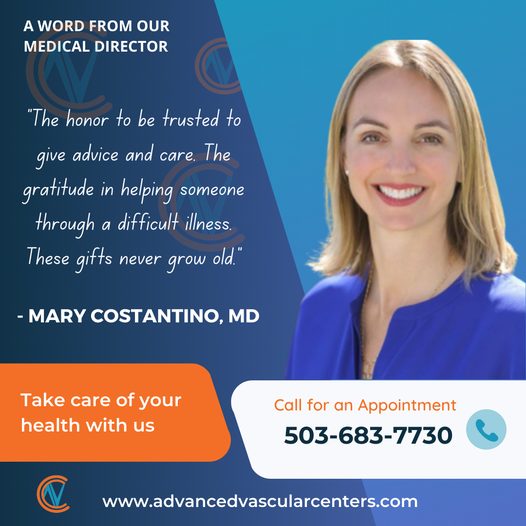
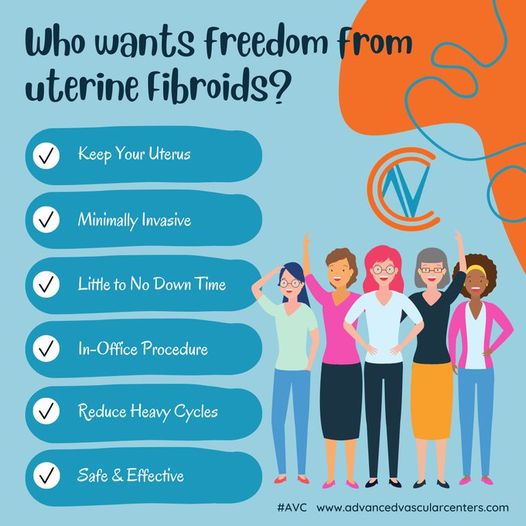
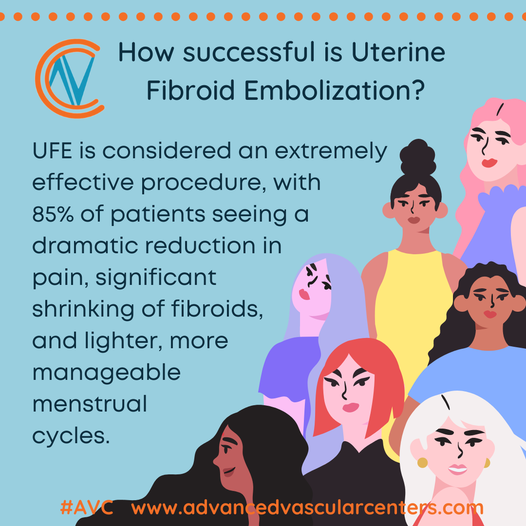

FAQS
UTERINE FIBROIDS ARE ONE OF THE MOST COMMON ISSUES WOMEN FACE IN THEIR HEALTH.
Uterine fibroids are the most common benign tumor of the uterus and can cause symptoms such as heavy bleeding, pelvic pain or pressure, painful sex, constipation, and urinary frequency. Despite being the most common gynecological condition, there is a lack of awareness and prioritization about uterine fibroids as an important health issue.
How do you get fibroids?
The exact cause of fibroids is unknown. They may be caused by estrogen (female hormone), genetic reasons, and more. When a woman’s estrogen levels are elevated, particularly during pregnancy, uterine fibroids tend to grow. They are additionally more likely to appear when a woman takes contraception pills that contain estrogen. Low estrogen levels can help fibroids shrink, which usually happens after menopause.
What happens if fibroids go untreated?
Fibroids, when left untreated, can worsen over time. They increase in both size and number, and as time goes on symptoms will continue to get worse and pain and bleeding will increase. Severe bleeding may lead to anemia (a low red blood cell count). Fibroids also negatively impact fertility.
Can fibroids turn into cancer?
Fibroids are almost always benign (not cancerous). Rarely (less than one in 1,000), a cancerous fibroid will occur. This is called leiomyosarcoma.
Are fibroid tumors cancerous?
Fibroids are muscular tumors that grow in the wall of the uterus. Uterine fibroids are almost always benign (non-cancerous). Rarely (less than one in 1,000) a cancerous fibroid will occur. It is called leiomyosarcoma. Doctors believe that these cancers do not arise from an already-existing fibroid. Having uterine fibroids also does not increase a woman’s chances of getting other forms of cancer in reproductive organs.
What is the most common type of uterine fibroid?
The three main types of fibroids include:
- Subserosal fibroids: These are the most common fibroids. They can push outside of the uterus into the pelvis.
- Intramural fibroids: These fibroids develop in the muscular wall of the uterus.
- Submucosal fibroids: These fibroids are uncommon.
How to diagnose fibroids?
Uterine fibroids are often discovered during a routine pelvic exam (especially if they are small and cause no symptoms). Your doctor may feel or see anomalies in your uterus that suggest uterine fibroids. If you have uterine fibroid symptoms, your gynecologist may recommend an ultrasound or a pelvic MRI to diagnose uterine fibroids.
How are fibroids treated?
Doctors often prescribe contraceptive pills (hormones) that can help minimize symptoms like heavy menstrual bleeding and pelvic pain (among other possible symptoms). It’s important to know that contraceptive pills do not eliminate fibroids. Fibroids can be treated by a procedure called Uterine Fibroid Embolization (nonsurgical fibroid treatment that is also known as Uterine Artery Embolization) or by surgery (myomectomy, hysterectomy).
How successful is Uterine Fibroid Embolization?
UFE is considered an extremely effective procedure, with 85% of patients seeing a dramatic reduction in pain, significant shrinking of fibroids, and lighter, more manageable menstrual cycles.
Can you feel uterine fibroids?
There are a variety of feelings you might experience if you have fibroids. If you have small fibroids, you may feel nothing at all and not even notice they’re there. For larger fibroids, however, you can experience discomforts and even pains related to the condition.
What does fibroid pain feel like?
Women with large or multiple fibroids have described a heavy pressure in their lower abdomen and pelvis. There can also be intense cramping and pain during intercourse and menstruation. The pain is often localized and acute. Lower back pain can be caused by fibroids putting pressure on nerves.
Can fibroids give you a big belly?
Larger fibroids may cause a woman to gain weight in the abdomen, giving the appearance of normal belly fat. Simply put, the more a fibroid grows, the heavier it will become. Consequently, weight gain and discomfort will follow as some fibroids can weigh up to as much as 20-40 pounds.
Can fibroids cause bleeding?
Unusual uterine bleeding is a common symptom of uterine fibroids. Bleeding resulting from fibroid presence normally happens when fibroids grow close to the lining of the uterus.
How quickly do uterine fibroids grow?
A research study revealed that average fibroid growth is 89% per 18 months. As a point of reference, a two-centimeter fibroid – about the size of a blueberry – is likely to take four to five years to double its diameter.
What causes uterine fibroids to grow?
Hormones. Estrogen and progesterone, two hormones that stimulate development of the uterine lining during each menstrual cycle in preparation for pregnancy, appear to promote the growth of fibroids. Fibroids contain more estrogen and progesterone receptors than typical uterine muscle cells do.
Can fibroids cause back pain?
Once in a while, fibroids press against muscles and nerves of the lower back and can cause back pain. Because fibroid symptoms depend on where exactly fibroids grow, not all women with fibroids experience back pain.
Сan fibroids cause frequent urination?
In some cases, uterine fibroids can press on the bladder causing frequent urination. Sometimes, women wake up at night to urinate (multiple times per night).
TESTIMONIALS
Jill’s Story
Meet Jill, a patient’s perspective on Uterine Artery Embolization.
Wendy’s Story
Meet Wendy, a Portland fibroid patient that was able to avoid surgery by having a Uterine Fibroid Embolization.
Jennifer’s Story
Jennifer had suffered through unbearably painful periods for her whole life until she found out about Uterine Fibroid Embolization.
Marsha’s Story
When she was first diagnosed with fibroids, Masha’s doctor told her that she should have a hysterectomy, Dr. Costantino helped her learn more about her options.
